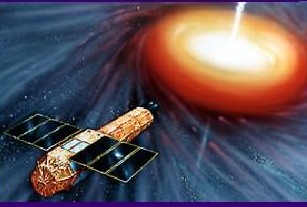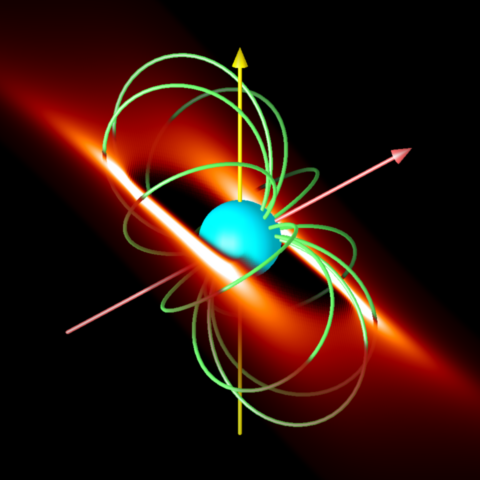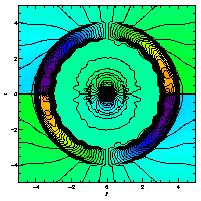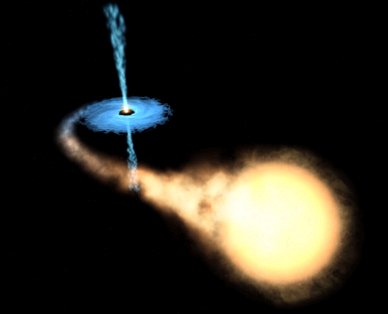MiMeS 2 Meeting
May 11 2009, 19:36
I'm currently attending the MiMeS 2 meeting, which is taking place at the beautiful Observatoire de Paris. This meeting brings together a large group of collaborators, working on both observational and theoretical aspects of magnetic massive stars.
We've only had one day of the meeting so far, but I've already learned a lot about crosstalk on spectropolarimeters (and why I shouldn't worry about it); seen convincing reports of a magnetic field in a Be star (a first, I believe); and enjoyed a very nice talk by Mary Oksala, presenting new surface abundance maps of σ Ori E. My spirits are being kept high both by the lovely Paris ambience, and by sharing a room with someone who likes good food as much as I do. Bon apetit, David Cohen!
Suzaku proposal accepted
Mar 8 2009, 21:22
David Morris informs me that our Suzaku proposal to study wind structure in high-mass X-ray binaries (HMXBs) has been accepted. (Full disclosure: I was very much a johnny-come-lately on this proposal, joining the team the day before the deadline!). The idea is to look for fluctuations in the X-ray brightness of the accreting compact object (neutron star or black hole) that arise when wind clumps pass through the line of sight. From measurements of the characteristic fluctuation timescale and amplitude, the hope is that we'll be able to obtain constraints on the size and density of the clumps — information that is sorely needed to unlock the mysterious origins of massive-star wind clumping.
My contribution to the project will be at the modeling end. A few months ago, some interesting conversations with Maurice Leutenegger (who is also on the Suzaku proposal, and in fact responsible for roping me in) led me to develop a clump variability code. It's nice to see that there are some real data on the horizon that the code can be used to interpret!
RRM movies uploaded
Mar 6 2009, 08:11
One of the reasons I created mad star was to collect together the various movies I create in the course of my research. As an initial step in this direction, I've uploaded a grid of movies based on my Rigidly Rotating Magnetosphere (RRM) model, spanning a range of rotation rates ω/ωc, observer inclinations i and magnetic obliquities β. Each movie shows the star and surrounding magneotspheric matter distribution, viewed over a complete rotation cycle. The movies can be downloaded individually or in groups, from here.
Supernova sweep-up of a magnetized wind
Feb 21 2009, 09:17
At the suggestion of Bryan Gaensler, I've been exploring what happens when a supernova (SN) explodes into a pre-existing, magnetized wind. If the progenitor star is rotating, then we can expect the magnetic field threading the wind to be wound up into an Archimedean spiral — much as happens for our own Sun. When the SN occurs, the wind will be swept up into a shell, and inside this shell the magnetic topology should be largely toroidal. This toroidal shell may be able to explain the unusual distribution of Faraday rotation seen in radio observations of some SN remnants (see Harvey-Smith et al. 2009).
To investigate this idea, I've run some MHD simulations on Medusa using the freely available Athena3D code. The initial state consists of a constant-velocity wind threaded by a 'split-monopole' radial/azimuthal field, which is outward in the northern hemisphere and inward in the southern hemisphere. When this initial state is disrupted by dumping a large quantity of thermal energy into a central sphere (basically, an SN explosion), the wind is indeed swept up into a shell, and the field in this shell is toroidal. However, as can be seen from this PostScript contour plot of the azimuthal field, there are north-south sign reversals in the direction of the field, which aren't seen in the observations. So, the jury is still out on this one...
New paper: 'Gamma-ray Variability from Wind Clumping in HMXBs with Jets'
Feb 8 2009, 00:58
The paper has just been accepted for publication in the Astrophysical Journal; it discusses γ-ray variability in so-called 'microquasars'. These are a subclass of high-mass X-ray binaries where jets from the compact object hit the wind of the companion star, producing pions that quickly decay into γ rays. If the wind is clumpy — as most massive-star winds are — then the γ ray production is expected to be variable, and observations of this variability can in principle help us to constrain the nature of the clumping.
My small contribution to the paper was figuring out that if we know the statistical properties of how a single wind clump interacts with the jet, then we can easily figure out how a whole ensemble of clumps behaves. The real work, however, was done by Stan Owocki and Gustavo Romero, and they deserve most of the credit for the paper.





